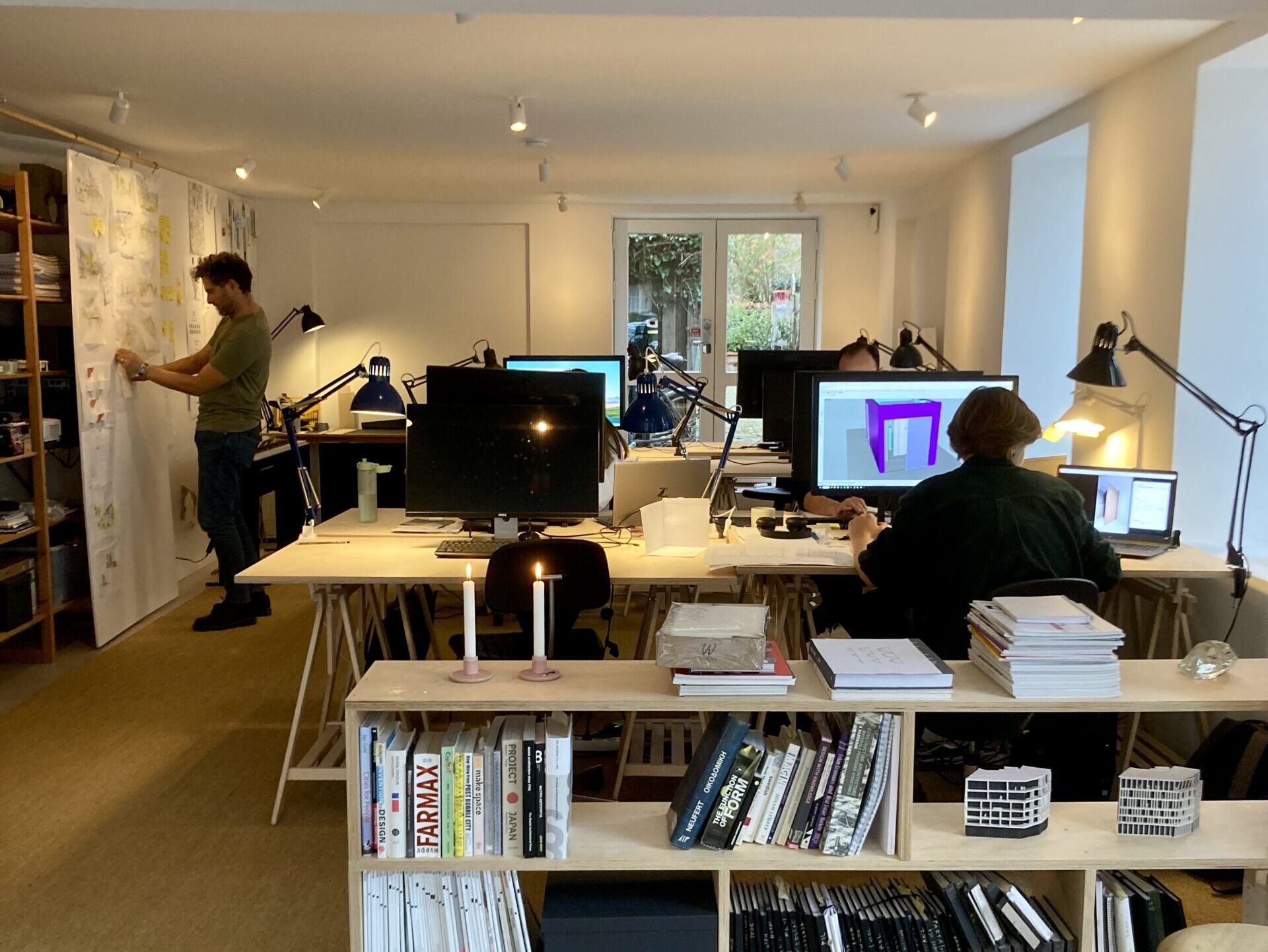In Japan, there has been an increasing discussion about how we could have a healthy working style to enjoy our life as well. From that perspective, Denmark has attracted lots of attention, because, in Denmark, it’s common for people to head home in the early evening to enjoy free time with family or friends, while consistently ranking first in the World Competitiveness Ranking in 2022 and 2023. (International Institute for Management Development)
The author currently works at an architectural studio in the capital city of Copenhagen, Denmark. Although generally it is said that architectural firms have one of the toughest working environments, I’ve discovered various insights about increasing the quality of working hours, especially about work environment and team management, not just about improving work efficiency. While this is just one case study, the author thought that specific examples may provide different insights that can not be found from data. Hence, this article was written focusing on SquareOne, which the author belongs to, and Kostas, the founder and representative of the studio.
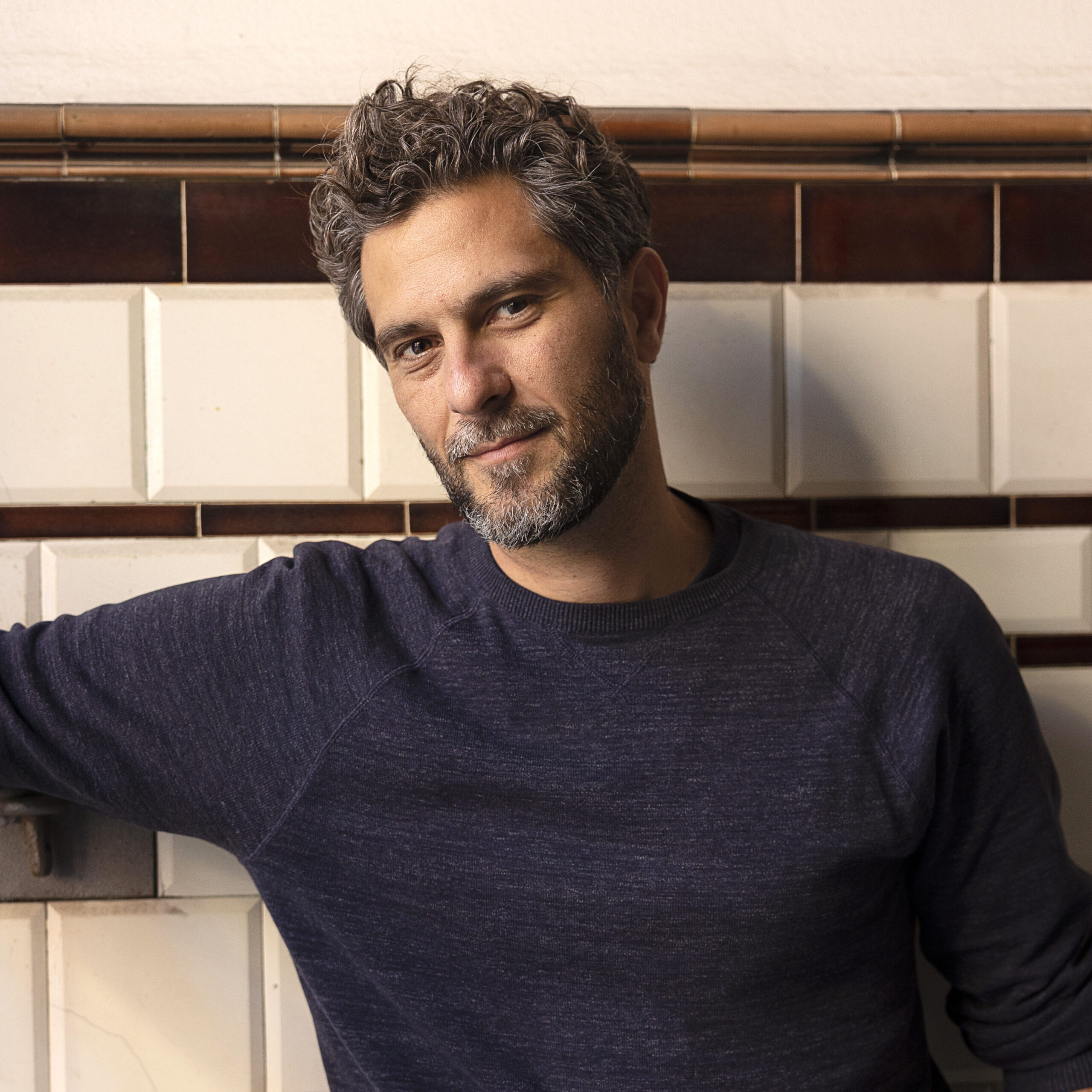
SQ-1 SquareOne
Works on projects not only in Denmark but also in various countries including Greece, Lithuania, other European countries, and Korea. The staff come from various countries such as Romania, Poland, Greece, Germany, Denmark, China, and Japan, incorporating remote work to accommodate different situations. In 2021, the office was relocated to its current location in Frederiksberg.
Work — SquareOne (sq-1.dk)
Kostas Poulopoulos
Originally from Greece. After obtaining a master’s degree in architecture in Greece, he moved to Japan where he earned another master’s degree in architecture and urban design from the University of Tokyo. During his studies, he also worked at the Kengo Kuma & Associates. After graduation, he moved to Denmark and worked at the international architectural firm Henning Larsen Architects, where he led various projects including headquarters for large corporations in Denmark and other European countries as the head of the international competition group. Later, he worked at another Danish architectural firm BIG (Bjarke Ingels Group) before establishing his own architectural studio, SquareOne (SQ-1), in 2015.
About — SquareOne (sq-1.dk)
Roles in Flat Hierarchies
In Denmark, whether in schools or workplaces, interpersonal relationships are very flat. We don’t use titles to call the others, and friends, professors, supervisors, and even CEOs are all called by their first names.(While the exact description couldn’t be found, speaking with Danish individuals suggests that this trend began around the year 2000.) The author also call the founder as “Kostas” and has never used titles like Mr. …. Hence, in this article, the founder will also be referred by his first name.
Divided and undivided works based on roles
Despite the flat nature of relationships, there are clear distinctions in roles based on positions. For instance, Kostas is responsible for making overall plans and final design decisions in projects, as well as making contracts and invoices.
On the other hand, regarding tasks which are not directly related to projects such as purchasing consumable items, sorting garbage, or even cleaning floors and windows, there is no specific person who is in charge of. The author found it quite intriguing that projects always stick to someone while everyday chores are recognized as ‘our task’ and is not stick to anyone.
Communication
Connections as a Person to Person
When the author started working at SquareOne, the most impressive thing was that Kostas paid lots of attention to the feelings of the staff. Despite having many responsibilities and decisions to make as the representative with the limitation of time, he always makes sure to speak to all staff members by the end of the day. What he speaks to is not something special, such as ‘How are you?’ or ‘(As for a project) How is it going?’. However, the author found that demonstrating genuine care and concern for the staff is the most important. When he had to leave early, he made sure to make eye contact with each staff member, and when remote staff came to the office, he was always the first one to welcome them warmly.
In this way, by receiving small daily messages of ‘it’s okay for you to be here’, a feeling of unity like a second family is nurtured. As a result, when Kostas returns from a week-long business trip, all staff members naturally greet him with hugs. Furthermore, not only for Kostas but also when a colleague returns after being absent due to illness, there’s a natural atmosphere of welcoming with hugs from everyone. It is clear how daily, subtle communications can profoundly influence the sense of unity within the team.
Lunch Together
Lunchtime is a shared moment for everyone at SquareOne. We sit together at a long table by the window, discussing topics unrelated to work. In Denmark, lunch breaks in schools and workplaces are usually 30 minutes, but the studio often extends it to about 40-50 minutes. We use this time to chat and laugh before returning to work in the afternoon.
Alcohol
Another integral part of the working culture at the studio is alcohol. In Denmark, where people can buy alcohol under 16.5% once they turn to 16 years old, it generally plays a significant role in socializing. Many Danish companies, including SquareOne, hold ‘Friday bars’ where instead of going out, they have drinks in the office. At SquareOne, while official Friday bars are held once in a few months, internal ones happen almost every Friday. We bring out beers from the fridge at around 4.00 or 5.00 PM on Fridays and enjoy snacks while chatting. We also celebrate with sparkling wine, strawberries, and grapes on special occasions.
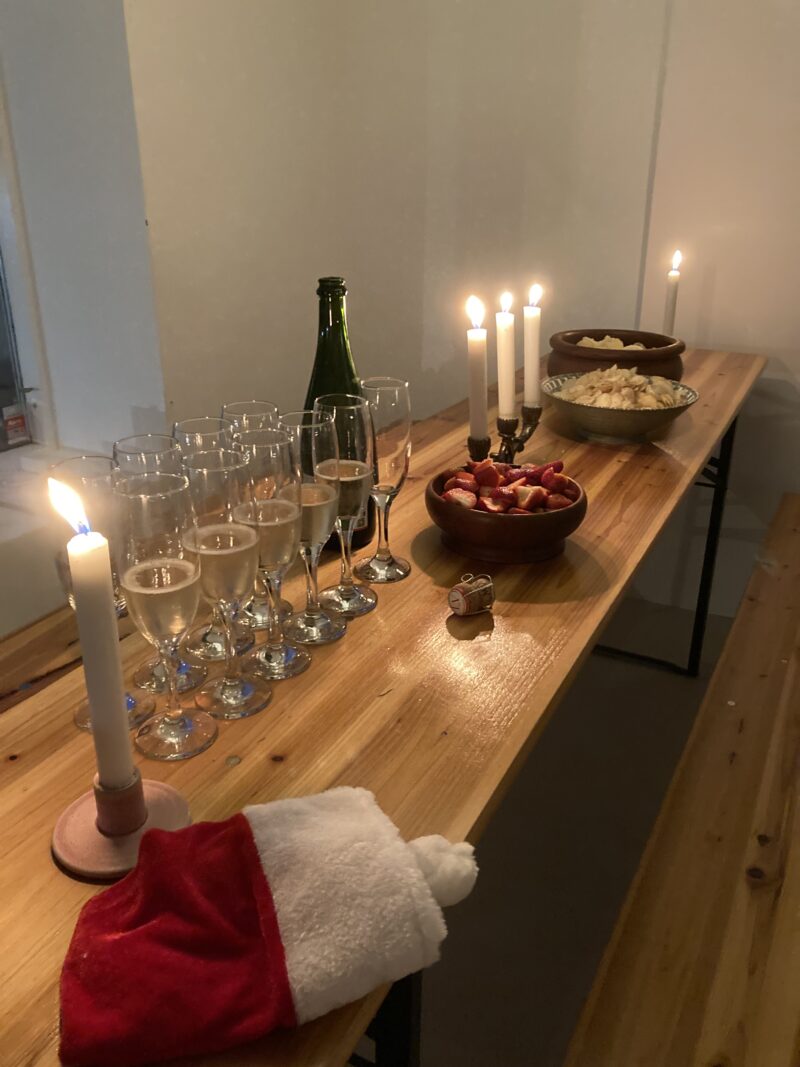
Education
Sharing Knowledge and Experience with No Hesitation
One of the surprising aspects, when I started working at SquareOne, was the willingness of Kostas and other colleagues to share knowledge and experience. Especially Kostas straightforwardly shares what he has learned through various challenges, including the reasons behind the lesson. This was something that my Polish colleague resonated strongly with. While Japan has a tradition of ‘learning by observing the back of master’, which may be beneficial for developing critical thinking and creativity through trial and error, the author saw the efficiency of direct teaching without misunderstandings within a limited time frame.
Embracing the Learning Curve
In Denmark, there’s generally no concept of a training period. While some companies or industries may have brief orientation sessions, basically employees are expected to join the team and make contributions immediately. Not offering the time for training for new staff directly related to increasing work efficiency and minimising labour costs. (Therefore, new graduates with little professional experience often face challenges finding employment. In fields like architecture in Denmark, it’s not surprising even for Danish people to spend nearly a year to find a job after graduation.) Therefore, the author was fascinated to know that the studio expects some time to learn new things basically for all projects. Indeed, the office seems to experiment with new techniques and knowledge with each project.
Workplace Environment
Spice to Work Hours – Music
Led by Kostas, many staff members at SquareOne are music enthusiasts. Each morning, someone plays music on Spotify, sharing tracks they find cool or impressive. Moreover, there is a piano in the studio, and it’s a common sight that Kostas starts playing it as background music for the studio when he feels tired and needs a fresh mind. The author has never witnessed this way of stress-relieving, but now, I consider it one of the most peaceful stress-relief methods. The interest in playing the piano is gradually spreading among staff members, and lately, I’ve also found myself joining a senior colleague for a duet after work. As another means of refreshment, there are fruits available on the long table, typically apples, bananas, and occasionally chocolate.
Workplace Visible from the Outside
The office is located on the ground floor of a building facing a bus street. Next to the long table used for meetings and lunches, there is a large window facing the street. We often make eye contact or exchange waves with people getting on and off the bus at the nearby bus stop or with pedestrians passing by. Just the other day, a pedestrian who noticed us laughing during a meeting smiled back at us, and another young man gestured with a big smile and a thumbs-up, saying, ‘Your office looks cool!’
Additionally, the office has several vertical windows on the side, which face a pathway leading to the backyard of the building. We often make eye contact with residents going to park their bikes in the backyard. In Denmark, it’s common not to have curtains on windows, so there’s always a consciousness of the connection with the outside. This is a personal observation, but I couldn’t help but feel that an open workplace environment, which could be seen by others, may encourage maintaining rationality and facilitate generally preferable behaviors, compared to an isolated environment. (I understand that it may be challenging to make it visible at some workplaces, especially due to confidentiality obligations, though.)
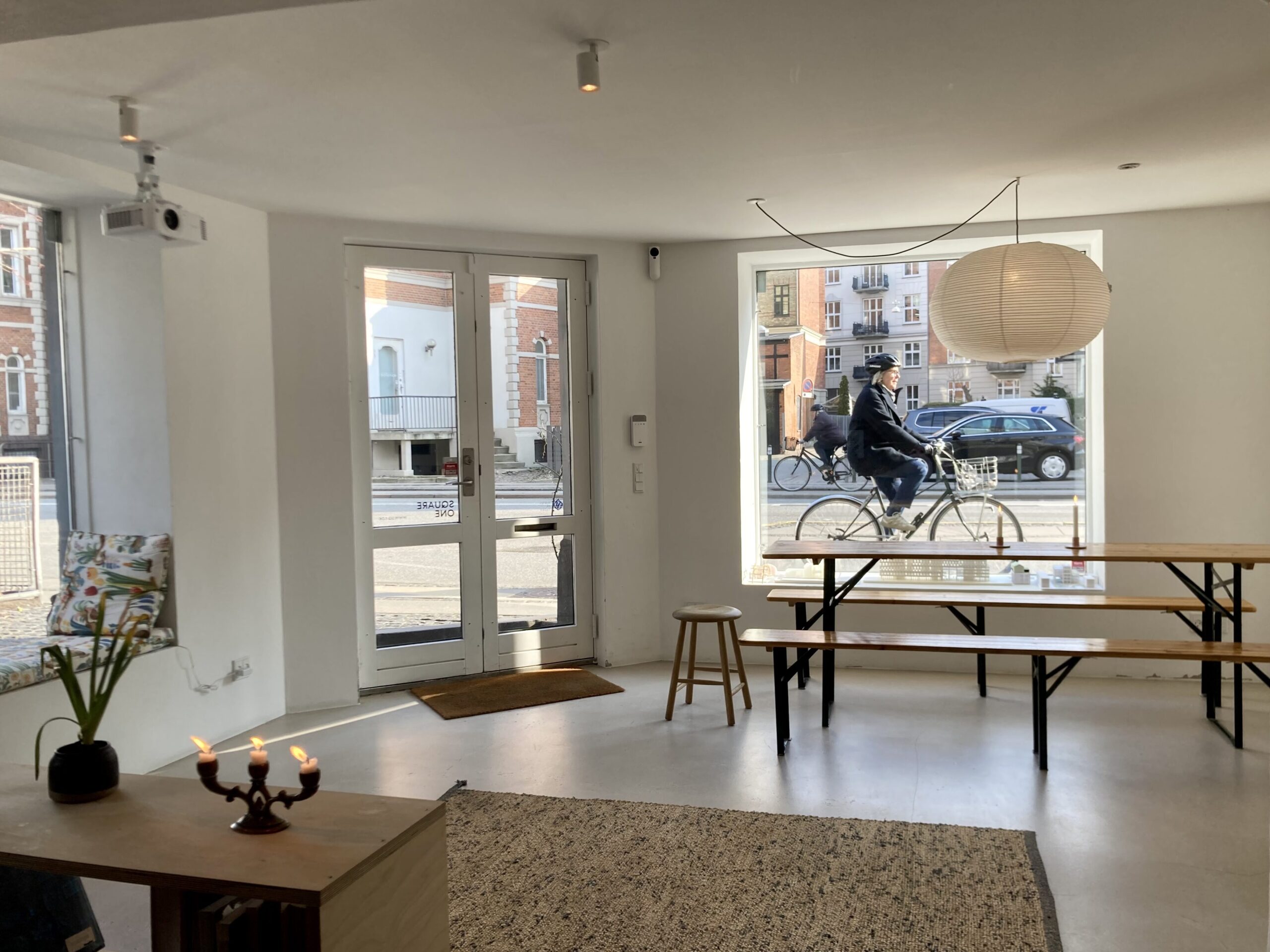
Warm Lighting
When it comes to Denmark, the word ‘Hygge’ has become popular in the world. From the author’s perspective, the studio feels like a very ‘Hygge’ space. For example, during the winter time, we light candles when we brew our first coffee upon arriving at the office. The main lighting in the studio is warm-toned desk lamps instead of the fluorescent lights on the ceiling.
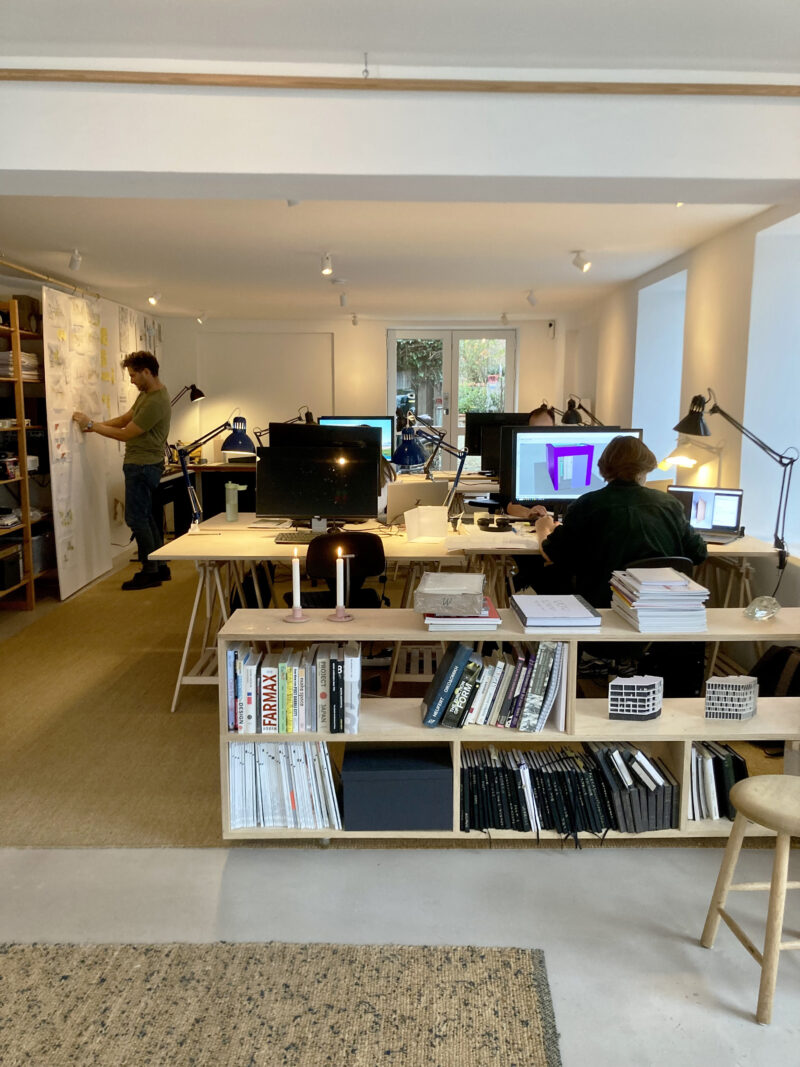
The margin for DIY
As mentioned earlier, the office relocated to its current location in 2021. Surprisingly, most of the renovations of the studio were done by Kostas and his friend Anna. The author feels the warmth of DIY (Do It Yourself) throughout the office, such as the adjustable working desks and a model-making space. Among them, the door for the meeting room is constructed with plywood on a rail. While it is different from perfect pre-fabricated doors, it works enough to minimize noise disruptions during meetings. Speaking from personal experience, as sliding doors are uncommon in Denmark, the sensation of opening and closing handmade sliding doors evokes an indescribable sense of excitement.
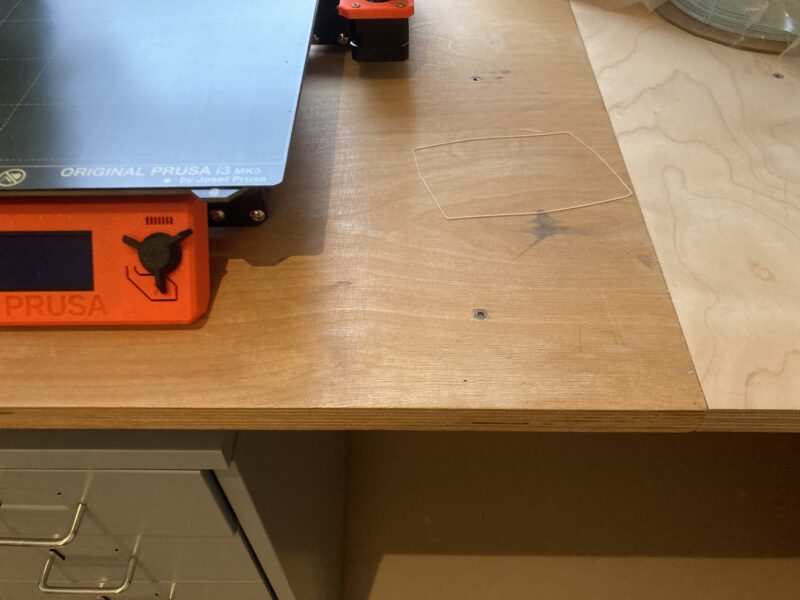
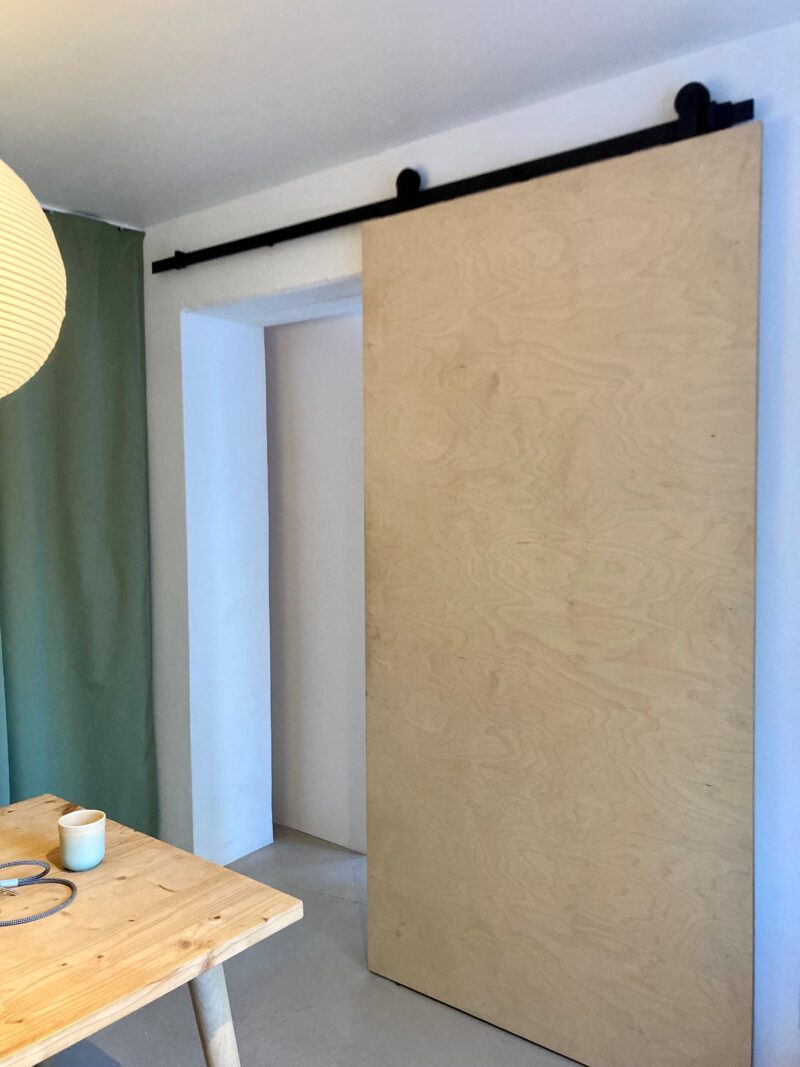
Since the office was originally built with a DIY ethos, additional DIY projects seamlessly integrate without any sense of incongruity. In the fall of 2023, a projector was installed utilizing other boards between the meeting room and the main room as a screen. The projector is utilized to show submitting projects for competitions or when visitors offer presentations, allowing all members to share and engage collaboratively.
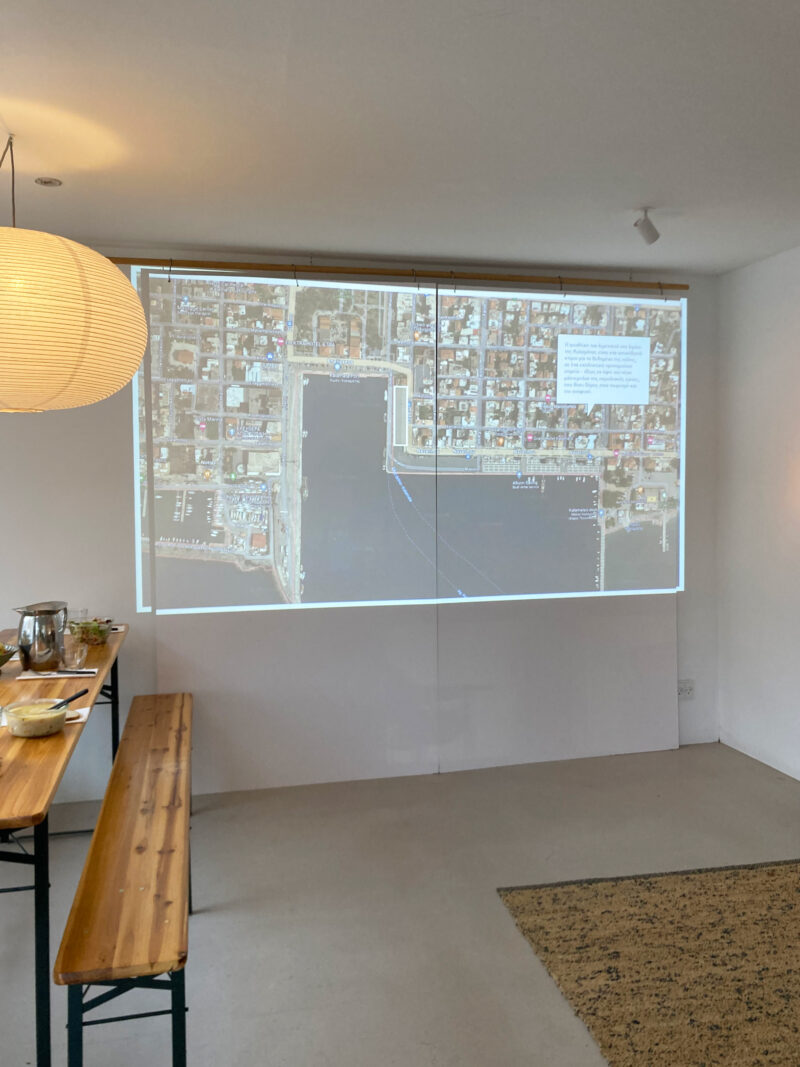
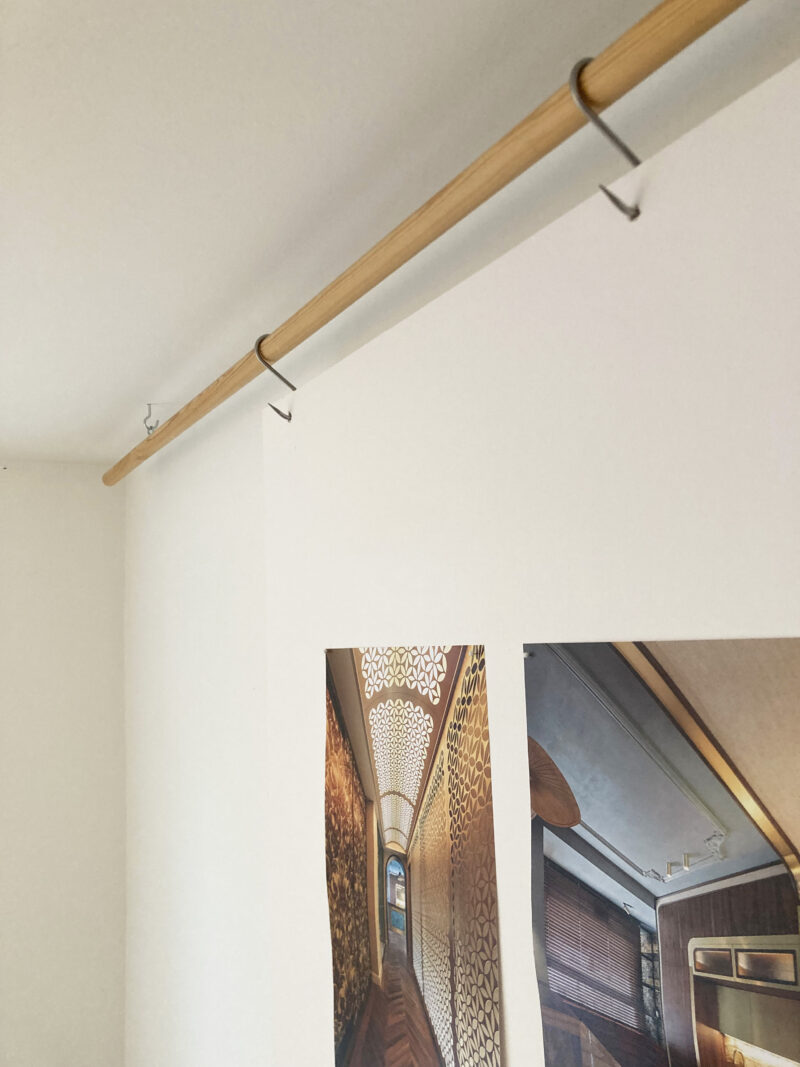
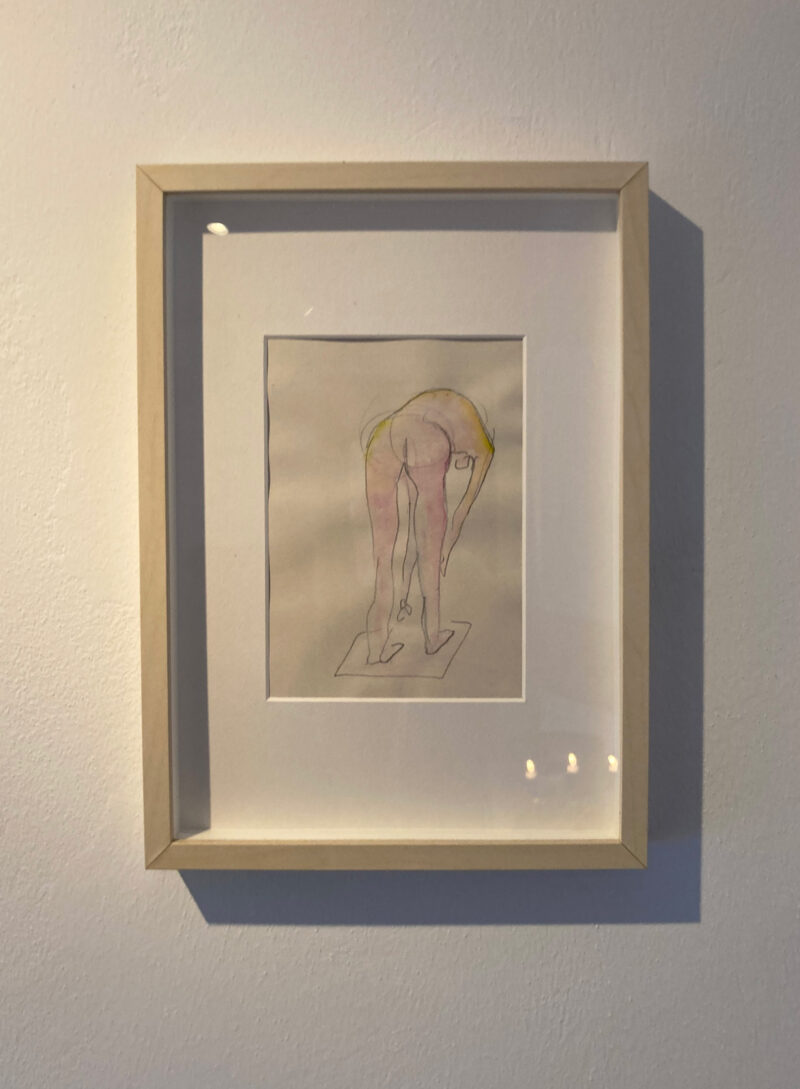
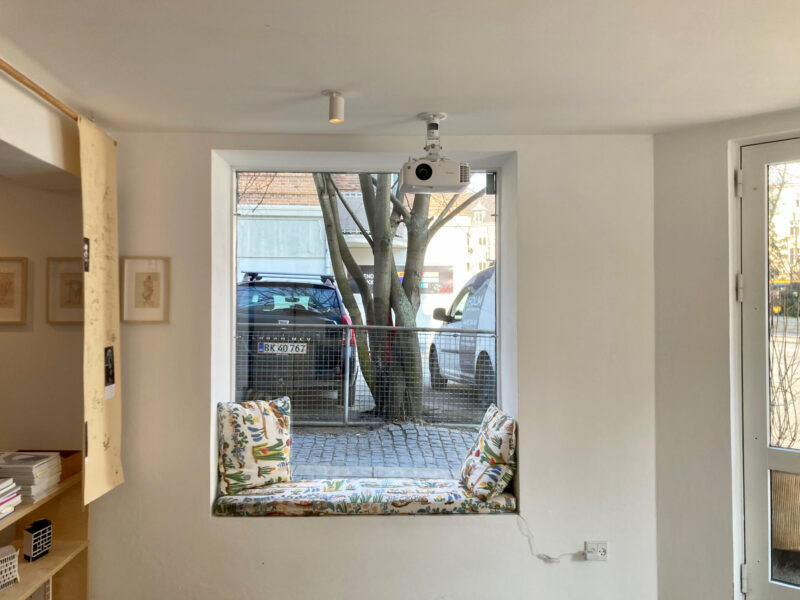
Teammate’s Emblem: Mug Cup
Geographically, Denmark is so close to the UK taking only two hours by flight. However, coffee is much more popular than tea in Denmark, and various offices own high-performance coffee machines. Our studio is no exception, with an espresso machine, and delicious coffee has become a daily pleasure for the staff. It has become a tradition at the studio to give mug cups from a handmade shop to newly joined staff to enjoy their daily coffee. While each cup’s design may vary, the author feels using the cup received from the studio as a gift enhances a sense of belonging to the organization naturally. The author can’t forget how much delighted when the author switched from a factory-made glass cup to a handmade mug cup chosen by Kostas.
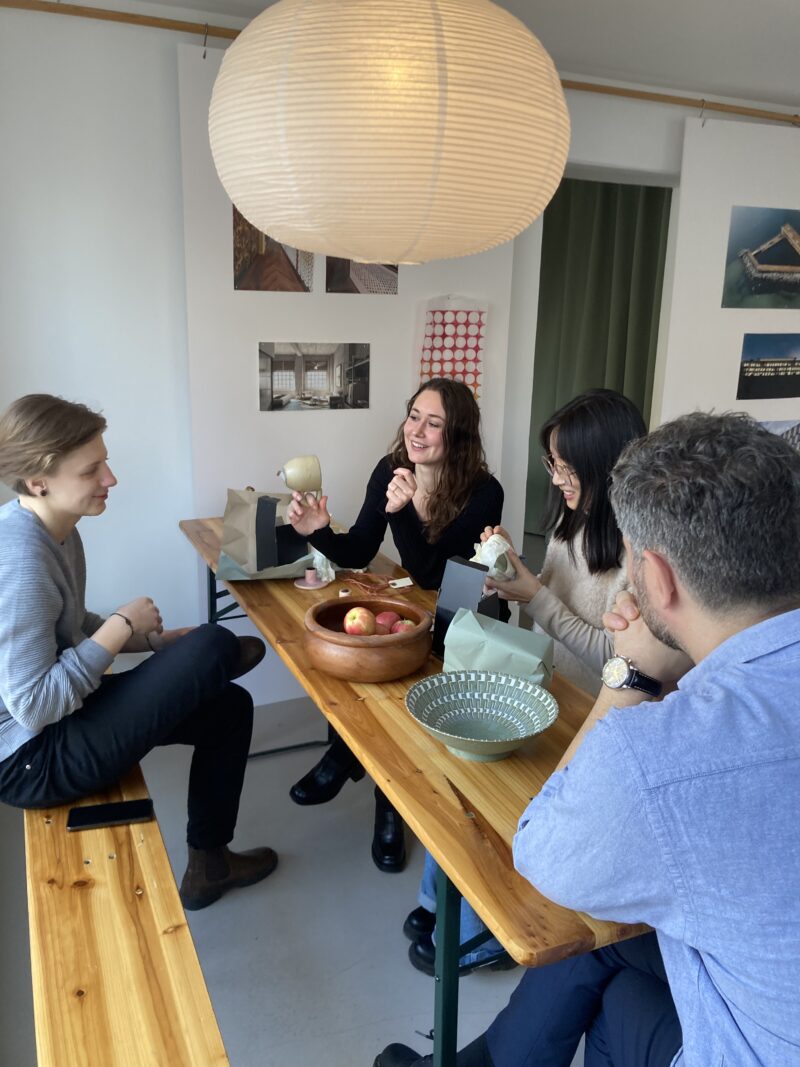
Architecture Projects
Careful Approach to Competitions
As mentioned earlier, Kostas has been a winner of several competitions. Therefore, one could say that he is well aware of the challenges and rigor of competition. While the office has acquired many projects through competitions, most of the projects currently in progress have been obtained through direct contracts with clients (commissions). I felt that having several projects that reliably generate income contributes to minimizing working hours.
Sharing Project Progress Internally and Regularly
Generally, 5-7 staff work at the studio. Therefore, there is no division of departments, and team members change according to projects and their status. Every Monday morning, a ‘Monday Meeting’ is held where each member reports on the progress of their projects while enjoying a cup of coffee. This meeting allows everyone to grasp the progress of each project, even if it’s they are not directly involved in the project. As a result, it creates an environment where it’s easy to ask for and offer help when needed.
Time Management
Loosely Controlled Working Hours
While it depends on the industry even in Denmark, there are no specific control for working hours at the studio. Although there is a contractual agreement on the number of hours to work per week, and the work is supposed to start around 9:00 AM, most of the people arrive after 9.00 AM. Similarly, while the official closing time is 5:00 PM, individuals can leave earlier if they have personal commitments. The author was surprised by the relaxed nature of managing working hours, remembering the experience of rushing to a station office to get a certification for even a 5-minute delay of a train in Japan.
However, neither Kostas nor all the staff compromise on the quality of their work. Despite sometimes arriving late, individuals may come early or stay late depending on project status. (occasionally stay until near midnight when deadlines approach.) The strong sense of professionalism regarding ‘what you bring to the table’ seems to create a balance between the quality of work and unrestricted working hours.
Trust Absences or Delays Without Proof
This is common in Denmark, where trust is fundamental for communication. For instance, even if someone is absent for several days due to illness, there is no requirement for a doctor’s note. Contrarily, in Germany, which is located next to Denmark, proof of illness from a doctor is mandatory for taking sick leave. The author found the cultural difference across European countries is striking.
Voice from Other Staff
Several staff members at SquareOne shared their insights on the distinctive features of working at SquareOne, drawing from their experiences in their respective home countries and at other architectural offices in Denmark.
・The biggest difference, I believe, lies in the work-life balance. In Poland, the standard working hour is 40 hours per week, while in Denmark, it’s 37 hours a week with minimal overtime. Compared to other major architectural firms in Poland and Denmark, SquareOne has a nice office with a feeling of cosy and friendly, as well as a good quality common space. Additionally, as it’s a small studio, I can be involved in a variety of tasks, and I find them a good experience. (From Poland, worked in Wroclaw and Copenhagen before)
・I’ve worked in two large Danish firms before, and I’ve enjoyed both workplaces because of the great people around me. If I were to find a difference, I’d say there is more safe space to ask, and I can get help easily. Also, due to the limited number of people, I can be involved in more interesting tasks, where I can see more contributions of mine within projects. (From Denmark, worked in Copenhagen before)
・The environment at the studio is very friendly, and it feels like a family. When I did an internship in Athens, I was immediately asked to join a project with strict tasks, so there were hardly any learning opportunities. However, here, people around me help me and I can learn. Also, there are opportunities for discussions, and I found the attitude of listening to others fascinating. I feel a spirit of ‘working as a team’ here. (From Greece, worked in Athens before)
・The atmosphere within the company is particularly good. I feel that everyone gets along well and respect each other. Including the equipment such as computers, there is a real sense of equality here between interns and regular staff. Regarding working hours, when I was at a Japanese architectural firm in Shanghai, it was common to work for 10 hours plus overtime, but here the basic working hours are 8 hours with no overtime, so the feeling while working is quite different. (From China, worked in Shanghai before)
Summary
As reflected on writing this article, the author realized that at least ten times of laughs are made at the studio every day. Each instance may seem subtle, but all instances are based on Kostas’ attitude of ‘not requiring perfection from himself or others’ and ‘his wish for the staff to enjoy their work and life’.
Certainly, it needs to be admitted that economic situations, such as the differences in design fees, play a significant role in creating such a comfortable work environment. However, considering the ongoing discussions about work styles especially in Japan, I hope that this kind of sharing can contribute to improving the working conditions and serve as an opportunity for as many people as possible to work comfortably.
Reference
International Institute for Management Development 国際経営開発研究所 (2023) “World Competitiveness Ranking”, [online]. Available at: https://www.imd.org/centers/wcc/world-competitiveness-center/rankings/world-competitiveness-ranking/ (Accessed: 4 Mar 2024)

